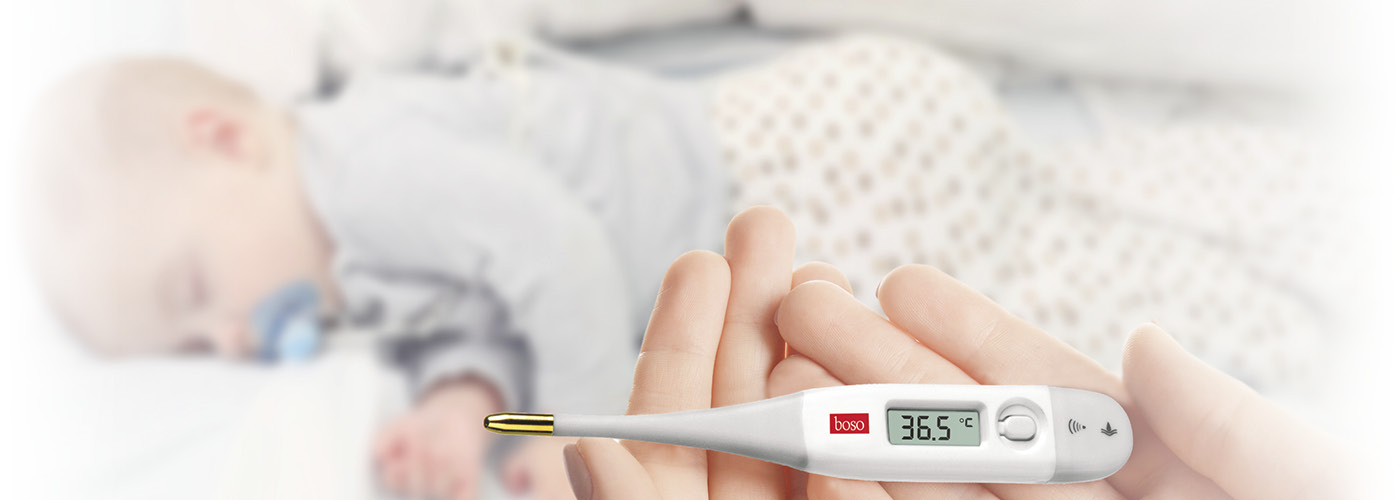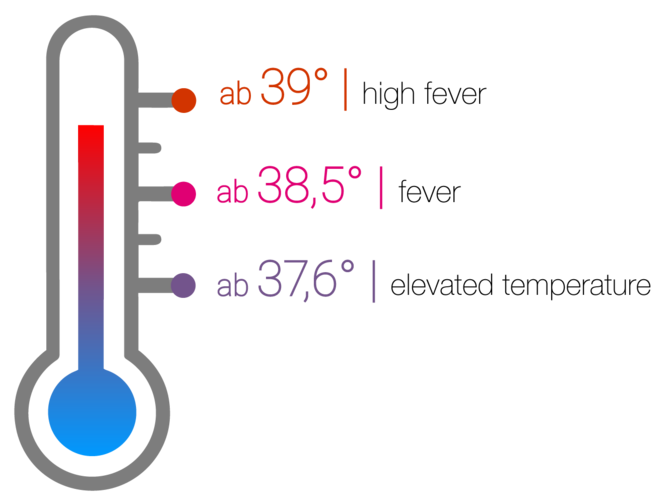
Measuring Body Temperature Correctly - Avoiding Risks
Your body temperature is one of the most important parameters for assessing your health status. Usually the first indication of an increased body temperature is personal discomfort. The measurement at home is the first step to decide on a medication or the consultation of a doctor. Therefore, exact and reliable results are very important.
For precise and reliable measurements, trust the fever thermometers from boso.

Adults
Usually the first indication of an increased body temperature is personal discomfort.
At the beginning of the fever, the patient feels tired, flaccid and exhausted. Some people have pain in their limbs or joints. The skin is pale while the hands, feet and nose are cold. When the temperature rises, the patient starts to shiver and get chills.
When the fever reaches its peak, the body is visibly heated. The sick person seems to be glowing: the face or the whole body is now red and hot.
Other symptoms of fever are: dry and hot skin, shiny eyes, sweating, coated tongue, chills with hot forehead and while feeling cold, loss of appetite, nausea with vomiting, constipation, restlessness, disorientation and hallucinations or an accelerated breathing rate.
Children
A child with a fever is quieter and calmer than normal. It is also more affectionate than usual and whimpers. Febrile children can also have orientation difficulties or seem to be hallucinating. If a child not only whimpers, but screams shrilly and at the same time has a considerable increase in body temperature, a doctor should be consulted immediately.
Regardless of whether you are an adult or a child, it is advisable to measure your body temperature with a thermometer at the first sign of a fever. This is the best way to monitor the development of the fever and intervene in good time.
Body temperature is one of the most important measurements for assessing the health of a person. It is advisable to measure the body temperature with a thermometer at the first signs of a fever (see How do I know I have a fever?). This is the best way to monitor the development of fever and intervene in good time.
Temperature measurements at home is often the decisive factor on the basis of which further steps such as taking medication or consulting a doctor are taken. Therefore, very reliable and exact measurement values are important.
There are several ways to measure body temperature. The process can be different, depending on the fever thermometer or body part where the temperature is measured.
In principle, it is recommended to measure the body temperature with a digital thermometer rectally, i.e. in the bottom, for example with the digital clinical thermometer bosotherm flex with a flexible tip.
If measurements are taken under the tongue or under the armpit, the measurement result is usually too low.
For measurements in the ear, an ear thermometer is recommended, which measures the body temperature via the outer auditory canal on the eardrum (auricular measurement). For example, the infrared ear thermometer bosotherm medical measures the temperature in only one second.
Measurements on the forehead are also possible. This method is particularly recommended for sleeping children. For this purpose, a contactless infrared thermometer should be used, such as bosotherm diagnostic, which allows a safe measurement on the forehead in only one second without touching.
No matter which measuring method you choose, the most important thing is to always measure at the same location on the body and preferably at the same time of day. This is the best way to monitor and control the course of the fever.
Do you have a fever? This table will help you to better classify your body temperature:
It is essential to ensure that the clinical thermometer is thoroughly disinfected after the measurement.
Glass thermometers are breakable and are not always easy to use due to the hard glass.
Digital clinical thermometers are partly made of more flexible materials, such as the bosotherm flex clinical thermometer. However, technical deviations can occur with digital thermometers, so the quality of the clinical thermometer should be taken into account.
A spare battery should always be at hand for all electronic clinical thermometers.
Whether the child has an elevated body temperature or a high fever, it is fundamentally important to:
- give pecial care and attention to the child.
- offer something to drink every half hour.
- offer easily digestible food.
- check temperature regularly.
- consult your pediatrician if you are worried.
- If the temperature is higher, bed rest or a quieter activity is recommended.
- In case of severe impairment of the child, antipyretic drugs (suppositories, juice) should be used in consultation with your doctor.
- If the child has a high fever, it is best to change undergarments more often and not to wrap the child too warmly.
- If the fever is high, a warm compress on the stomach or calf could be helpful.
(Source: Bundeszentrale für gesundheitliche Aufklärung | BZgA | Status: January 2019)

The German Federal Center for Health Education (Bundeszentrale für gesundheitliche Aufklärung) has summarized the following guidelines (as of Jan. 19):
